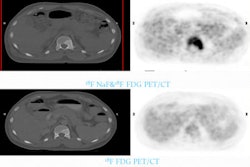PET developer Naviscan is touting clinical results presented at last week's National Consortium of Breast Centers (NCBC) meeting. According to the company, its positron emission mammography (PEM) technology demonstrated higher specificity for detecting cancer in the contralateral breast than MRI, with equal sensitivity.
Prior studies indicate that women with newly diagnosed breast cancer have a 3% to 5% incidence of cancer in the contralateral breast, Naviscan said. Breast MRI has traditionally been used following mammography to assess for additional cancer, but the firm believes its PEM technology could be more effective.
The prospective study examined 208 women who were seen at Boca Raton Regional Hospital. The results indicated that 71 women had contralateral lesions identified by either MRI or PEM, producing a sensitivity of 83%; however, PEM showed specificity of 80%, compared with 63% for MRI. The study also found that PEM was not influenced by menopausal status or breast density.
The study used the same patient population as research on PEM for the ipsilateral breast presented in the European Journal of Nuclear Medicine. That paper showed that PEM had a 6% improvement over breast MRI in specificity.




















